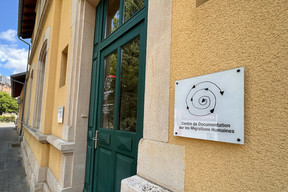Want to travel without going too far? Just ten minutes from the centre of Dudelange, in the south of the country, the Italian quarter is well worth a visit. And, contrary to what its name might suggest, the neighbourhood resembles Lisbon: its colourful houses and a few decorative elements here and there on the houses give the impression of a trip to the Portuguese capital.
It has to be said that the district has changed radically. That’s what Vítor Santos has seen for himself. A volunteer at Radio Dudelange, this native of Portugal moved to Dudelange with his family when he was five. He lived here for a long time. Although he has now moved to the nearby Schmelz district, he still keeps a close eye on his childhood neighbourhood, and returns to it almost every day.
The district was born at the end of the 19th century, with the beginnings of the steel industry. At the time, it was home to a fairly modest population. The steel crisis in 1970 led to a decline in Italian immigration, and the Portuguese became more numerous. Today, the district is more cosmopolitan.
“At the time, the district was mainly inhabited by Italians, who arrived long before the Portuguese. Most of the local residents worked in the Arbed factory. I remember trains loaded with steel that was still molten. The district was very big, and I remember that when I arrived, I almost thought I was in a science fiction film,” says Santos. “Today, the district has regained its colour, but some vestiges of the past remain, as does the spirit that reigned in the district.”
“There’s less closeness between residents today than there was back then, but I think it’s the same everywhere. But there’s still that spirit of cohesion. For example, when there’s a party in the neighbourhood, it attracts the other residents of Dudelange too. Otherwise, the buildings have been refurbished, and today they’re full of colourful little houses. It gives the area a different feel, it’s more modern, and the local authority is doing a lot to keep it lively,” he says.
An immersive experience to delve into the history of the district
Here, the old rubs shoulders with the new, giving the district its distinctive look. The brand new, colourful crèche stands side by side with remnants of the steel industry. The district has its own railway station, Dudelange-Usines, “one of whose platforms is currently being extended,” according to the local authority. Its concourse has been transformed and now houses the Documentation Centre for Human Migrations (CDMH). The CDMH offers visitors to the district an immersive experience, using digital technology to take them 40 years back in time.
Here and there in the district, red signs displaying a QR code have been installed. Once you have scanned the code, you can immerse yourself in the history of the district. The experience is also available on a computer, via the Movinglusitalia.org website. This interactive digital tool provides a map of the district at the time, allowing visitors to explore some of the key sites in this area in the southwestern part of the city. At each location, you can discover audio testimonies, photos from the period and more.
Some businesses hold out
“At the time, there were a lot of cafés where people met. Almost all of them have now closed. But there is a neighbourhood committee that helps to create links between residents,” says Santos. He is a member of the Schmelz neighbourhood committee, but the two bodies are also working together to create links between neighbourhoods.
And the two will soon be linked by a new district under construction: . This is also where , has just opened.
In the Italian quarter, the Taverna restaurant continues to attract regulars, while the Café Inès, run by a well-known local figure, is also a meeting place for local residents. Other businesses include Trolux GmBH, a construction company that has been in existence since 1997, as well as the Tattenberg bookshop and the must-visit pizzeria Gigi l’Amoroso. In terms of services, the district is home to a school, a crèche that opened in 2022 and a centre for children in difficult situations.

Next to the Italian district, a new district is being built: NeiSchmelz. Photo: Maëlle Hamma/Maison Moderne
Six associations are also active in the district, helping to bring it to life. When asked about what needs to change in the neighbourhood, Santos gives a clear answer: “Nothing. We don’t need to change anything, but we do need each and every resident to continue to do their part.” The only downside, in his view, is the difficulty of parking in the district. This should improve, however, as the local authority has planned to redevelop the public car park for visitors to the Haard area.

The Italian district is located in the southeast part of the municipality of Dudelange. It covers an area of around 14 hectares. Visual: Shutterstock/Maison Moderne
This story was first published in French on . It has been translated and edited for Delano.
















